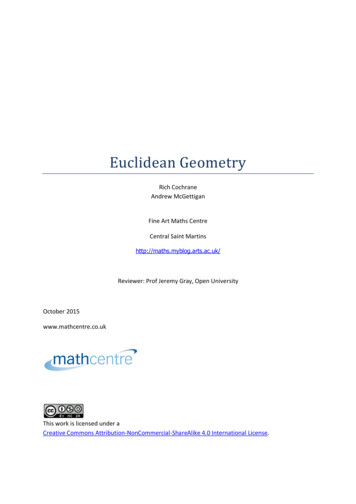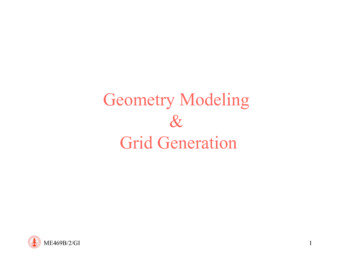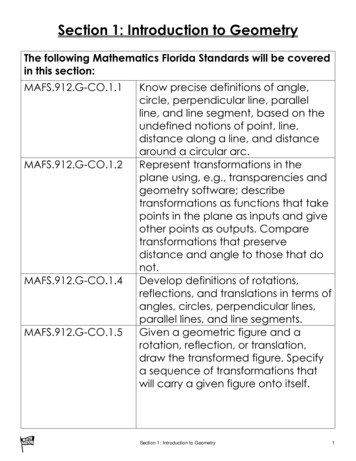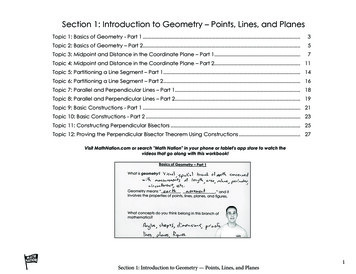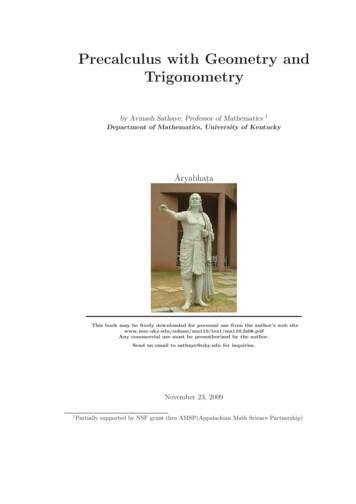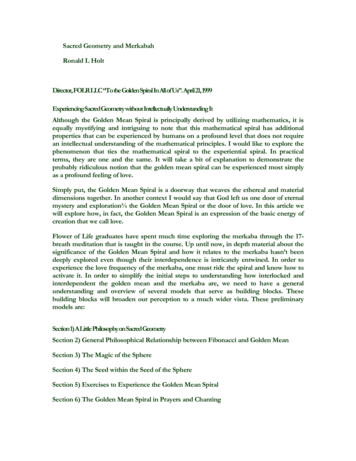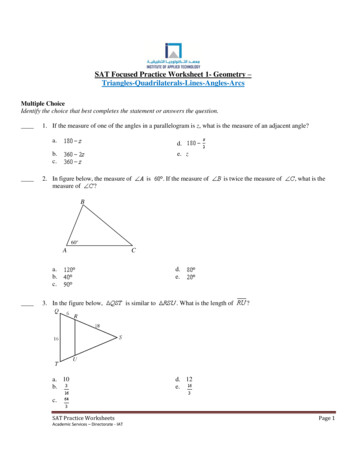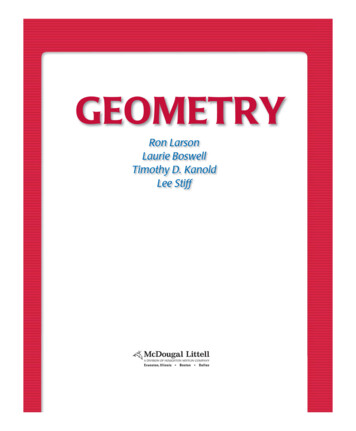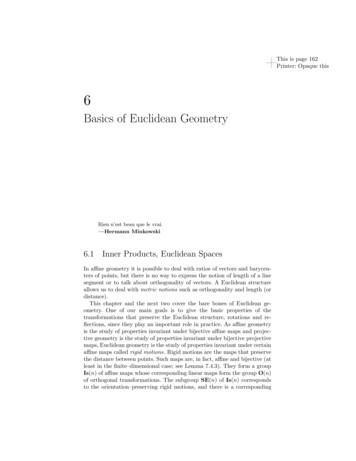
Transcription
This is page 162Printer: Opaque this6Basics of Euclidean GeometryRien n’est beau que le vrai.—Hermann Minkowski6.1 Inner Products, Euclidean SpacesIn affine geometry it is possible to deal with ratios of vectors and barycenters of points, but there is no way to express the notion of length of a linesegment or to talk about orthogonality of vectors. A Euclidean structureallows us to deal with metric notions such as orthogonality and length (ordistance).This chapter and the next two cover the bare bones of Euclidean geometry. One of our main goals is to give the basic properties of thetransformations that preserve the Euclidean structure, rotations and reflections, since they play an important role in practice. As affine geometryis the study of properties invariant under bijective affine maps and projective geometry is the study of properties invariant under bijective projectivemaps, Euclidean geometry is the study of properties invariant under certainaffine maps called rigid motions. Rigid motions are the maps that preservethe distance between points. Such maps are, in fact, affine and bijective (atleast in the finite–dimensional case; see Lemma 7.4.3). They form a groupIs(n) of affine maps whose corresponding linear maps form the group O(n)of orthogonal transformations. The subgroup SE(n) of Is(n) correspondsto the orientation–preserving rigid motions, and there is a corresponding
6.1. Inner Products, Euclidean Spaces163subgroup SO(n) of O(n), the group of rotations. These groups play a veryimportant role in geometry, and we will study their structure in some detail.Before going any further, a potential confusion should be cleared up.¡ Euclidean geometry deals with affine spaces E, E where the associated vector space E is equipped with an inner product. Such spaces are calledEuclidean affine spaces. However, inner products are defined on vectorspaces. Thus, we must first study the properties of vector spaces equippedwith an inner product, and the linear maps preserving an inner product(the orthogonal group SO(n)). Such spaces are called Euclidean spaces(omitting the word affine). It should be clear from the context whether weare dealing with a Euclidean vector space or a Euclidean affine space, butwe will try to be clear about that. For instance, in this chapter, exceptfor Definition 6.2.9, we are dealing with Euclidean vector spaces and linearmaps.We begin by defining inner products and Euclidean spaces. The Cauchy–Schwarz inequality and the Minkowski inequality are shown. We defineorthogonality of vectors and of subspaces, orthogonal bases, and orthonormal bases. We offer a glimpse of Fourier series in terms of the orthogonalfamilies (sin px)p 1 (cos qx)q 0 and (eikx )k Z . We prove that every finite–dimensional Euclidean space has orthonormal bases. Orthonormal basesare the Euclidean analogue for affine frames. The first proof uses duality, and the second one the Gram–Schmidt orthogonalization procedure.The QR-decomposition for invertible matrices is shown as an applicationof the Gram–Schmidt procedure. Linear isometries (also called orthogonaltransformations) are defined and studied briefly. We conclude with a shortsection in which some applications of Euclidean geometry are sketched.One of the most important applications, the method of least squares, isdiscussed in Chapter 13.For a more detailed treatment of Euclidean geometry, see Berger [12, 13],Snapper and Troyer [160], or any other book on geometry, such as Pedoe[136], Coxeter [35], Fresnel [66], Tisseron [169], or Cagnac, Ramis, andCommeau [25]. Serious readers should consult Emil Artin’s famous book[4], which contains an in-depth study of the orthogonal group, as well asother groups arising in geometry. It is still worth consulting some of theolder classics, such as Hadamard [81, 82] and Rouché and de Comberousse[144]. The first edition of [81] was published in 1898, and finally reachedits thirteenth edition in 1947! In this chapter it is assumed that all vectorspaces are defined over the field R of real numbers unless specified otherwise(in a few cases, over the complex numbers C).First, we define a Euclidean structure on a vector space. Technically,a Euclidean structure over a vector space E is provided by a symmetricbilinear form on the vector space satisfying some extra properties. Recallthat a bilinear form ϕ: E E R is definite if for every u E, u 6 0implies that ϕ(u, u) 6 0, and positive if for every u E, ϕ(u, u) 0.
1646. Basics of Euclidean GeometryDefinition 6.1.1 A Euclidean space is a real vector space E equippedwith a symmetric bilinear form ϕ: E E R that is positive definite.More explicitly, ϕ: E E R satisfies the following axioms:ϕ(u1 u2 , v) ϕ(u1 , v) ϕ(u2 , v),ϕ(u, v1 v2 ) ϕ(u, v1 ) ϕ(u, v2 ),ϕ(λu, v) λϕ(u, v),ϕ(u, λv) λϕ(u, v),ϕ(u, v) ϕ(v, u),u 6 0 implies that ϕ(u, u) 0.The real number ϕ(u, v) is also called the inner product (or scalar product)of u and v. We also define the quadratic form associated with ϕ as thefunction Φ: E R such thatΦ(u) ϕ(u, u),for all u E.Since ϕ is bilinear, we have ϕ(0, 0) 0, and since it is positive definite,we have the stronger fact thatϕ(u, u) 0iffu 0,that is, Φ(u) 0 iff u 0.Given an inner product ϕ: E E R on a vector space E, we alsodenote ϕ(u, v) bypand Φ(u) by kuk.u·vorhu, vior(u v),Example 6.1 The standard example of a Euclidean space is Rn , underthe inner product · defined such that(x1 , . . . , xn ) · (y1 , . . . , yn ) x1 y1 x2 y2 · · · xn yn .There are other examples.Example 6.2 For instance, let E be a vector space of dimension 2, andlet (e1 , e2 ) be a basis of E. If a 0 and b2 ac 0, the bilinear formdefined such thatϕ(x1 e1 y1 e2 , x2 e1 y2 e2 ) ax1 x2 b(x1 y2 x2 y1 ) cy1 y2yields a Euclidean structure on E. In this case,Φ(xe1 ye2 ) ax2 2bxy cy 2 .Example 6.3 Let C[a, b] denote the set of continuous functions f : [a, b] R. It is easily checked that C[a, b] is a vector space of infinite dimension.
6.1. Inner Products, Euclidean Spaces165Given any two functions f, g C[a, b], letZ bf (t)g(t)dt.hf, gi aWe leave as an easy exercise that h , i is indeed an inner product onC[a, b]. In the case where a π and b π (or a 0 and b 2π, thismakes basically no difference), one should computehsin px, sin qxi,hsin px, cos qxi,andhcos px, cos qxi,for all natural numbers p, q 1. The outcome of these calculations is whatmakes Fourier analysis possible!Let us observe that ϕ can be recovered from Φ. Indeed, by bilinearityand symmetry, we haveΦ(u v) ϕ(u v, u v) ϕ(u, u v) ϕ(v, u v) ϕ(u, u) 2ϕ(u, v) ϕ(v, v) Φ(u) 2ϕ(u, v) Φ(v).Thus, we have1[Φ(u v) Φ(u) Φ(v)].2We also say that ϕ is the polar form of Φ. We will generalize polar formsto polynomials, and we will see that they play a very important role.One of thep very important properties of an inner product ϕ is that themap u 7 Φ(u) is a norm.ϕ(u, v) Lemma 6.1.2 Let E be a Euclidean space with inner product ϕ, and let Φbe the corresponding quadratic form. For all u, v E, we have the Cauchy–Schwarz inequalityϕ(u, v)2 Φ(u)Φ(v),the equality holding iff u and v are linearly dependent.We also have the Minkowski inequalitypppΦ(u v) Φ(u) Φ(v),the equality holding iff u and v are linearly dependent, where in addition ifu 6 0 and v 6 0, then u λv for some λ 0.Proof . For any vectors u, v E, we define the function T : R R suchthatT (λ) Φ(u λv),for all λ R. Using bilinearity and symmetry, we haveΦ(u λv) ϕ(u λv, u λv)
1666. Basics of Euclidean Geometry ϕ(u, u λv) λϕ(v, u λv) ϕ(u, u) 2λϕ(u, v) λ2 ϕ(v, v) Φ(u) 2λϕ(u, v) λ2 Φ(v).Since ϕ is positive definite, Φ is nonnegative, and thus T (λ) 0 for allλ R. If Φ(v) 0, then v 0, and we also have ϕ(u, v) 0. In this case,the Cauchy–Schwarz inequality is trivial, and v 0 and u are linearlydependent.Now, assume Φ(v) 0. Since T (λ) 0, the quadratic equationλ2 Φ(v) 2λϕ(u, v) Φ(u) 0cannot have distinct real roots, which means that its discriminant 4(ϕ(u, v)2 Φ(u)Φ(v))is null or negative, which is precisely the Cauchy–Schwarz inequalityϕ(u, v)2 Φ(u)Φ(v).Ifϕ(u, v)2 Φ(u)Φ(v),then the above quadratic equation has a double root λ0 , and we haveΦ(u λ0 v) 0. If λ0 0, then ϕ(u, v) 0, and since Φ(v) 0, we musthave Φ(u) 0, and thus u 0. In this case, of course, u 0 and v arelinearly dependent. Finally, if λ0 6 0, since Φ(u λ0 v) 0 implies thatu λ0 v 0, then u and v are linearly dependent. Conversely, it is easy tocheck that we have equality when u and v are linearly dependent.The Minkowski inequalitypppΦ(u v) Φ(u) Φ(v)is equivalent toΦ(u v) Φ(u) Φ(v) 2However, we have shown thatpΦ(u)Φ(v).2ϕ(u, v) Φ(u v) Φ(u) Φ(v),and so the above inequality is equivalent topϕ(u, v) Φ(u)Φ(v),which is trivial when ϕ(u, v) 0, and follows from the Cauchy–Schwarzinequality when ϕ(u, v) 0. Thus, the Minkowski inequality holds. Finally,assume that u 6 0 and v 6 0, and thatpppΦ(u v) Φ(u) Φ(v).When this is the case, we haveϕ(u, v) pΦ(u)Φ(v),
6.1. Inner Products, Euclidean Spacesu167vu vFigure 6.1. The triangle inequalityand we know from the discussion of the Cauchy–Schwarz inequality that theequality holds iff u and v are linearly dependent. The Minkowski inequalityis an equality when u or v is null. Otherwise, if u 6 0 and v 6 0, then u λvfor some λ 6 0, and sincepϕ(u, v) λϕ(v, v) Φ(u)Φ(v),by positivity, we must have λ 0.Note that the Cauchy–Schwarz inequality can also be written aspp ϕ(u, v) Φ(u) Φ(v).Remark: It is easy to prove that the Cauchy–Schwarz and the Minkowskiinequalities still hold for a symmetric bilinear form that is positive, but notnecessarily definite (i.e., ϕ(u, v) 0 for all u, v E). However, u and vneed not be linearly dependent when the equality holds.The Minkowski inequalitypppΦ(u v) Φ(u) Φ(v)pshows that the map u 7 Φ(u) satisfies the convexity inequality (alsoknown as triangle inequality), condition (N3) of Definition 17.2.2, and sinceϕ is bilinear and positive definite, it also satisfies conditions (N1) and (N2)of Definition 17.2.2, and thus it is a norm on E. The norm induced by ϕis called the Euclidean norm induced by ϕ.Note that the Cauchy–Schwarz inequality can be written as u · v kukkvk,and the Minkowski inequality asku vk kuk kvk.Figure 6.1 illustrates the triangle inequality.We now define orthogonality.
1686. Basics of Euclidean Geometry6.2 Orthogonality, Duality, Adjoint of a LinearMapAn inner product on a vector space gives the ability to define the notionof orthogonality. Families of nonnull pairwise orthogonal vectors must belinearly independent. They are called orthogonal families. In a vector spaceof finite dimension it is always possible to find orthogonal bases. This isvery useful theoretically and practically. Indeed, in an orthogonal basis,finding the coordinates of a vector is very cheap: It takes an inner product.Fourier series make crucial use of this fact. When E has finite dimension, weprove that the inner product on E induces a natural isomorphism betweenE and its dual space E . This allows us to define the adjoint of a linearmap in an intrinsic fashion (i.e., independently of bases). It is also possibleto orthonormalize any basis (certainly when the dimension is finite). Wegive two proofs, one using duality, the other more constructive using theGram–Schmidt orthonormalization procedure.Definition 6.2.1 Given a Euclidean space E, any two vectors u, v E areorthogonal, or perpendicular , if u · v 0. Given a family (ui )i I of vectorsin E, we say that (ui )i I is orthogonal if ui · uj 0 for all i, j I, wherei 6 j. We say that the family (ui )i I is orthonormal if ui · uj 0 for alli, j I, where i 6 j, and kui k ui · ui 1, for all i I. For any subset Fof E, the setF {v E u · v 0, for all u F },of all vectors orthogonal to all vectors in F , is called the orthogonalcomplement of F .Since inner products are positive definite, observe that for any vectoru E, we haveu·v 0for all v Eiffu 0.It is immediately verified that the orthogonal complement F of F is asubspace of E.Example 6.4 Going back to Example 6.3 and to the inner productZ πf (t)g(t)dthf, gi πon the vector space C[ π, π], it is easily checked that½π if p q, p, q 1,hsin px, sin qxi 0 if p 6 q, p, q 1,hcos px, cos qxi ½π0if p q, p, q 1,if p 6 q, p, q 0,
6.2. Orthogonality, Duality, Adjoint of a Linear Map169andhsin px, cos qxi 0,Rπfor all p 1 and q 0, and of course, h1, 1i π dx 2π.As a consequence, the family (sin px)p 1 (cos qx)q 0 is orthogonal. It isnot orthonormal, but becomes so if we divide every trigonometric functionby π, and 1 by 2π.Remark: Observe that if we allow complex–valued functions, we obtainsimpler proofs. For example, it is immediately checked that½Z π2π if k 0,ikxe dx 0if k 6 0, πbecause the derivative of eikx is ikeikx .ÄHowever, beware that something strange is going on. Indeed,unless k 0, we haveheikx , eikx i 0,sinceheikx , eikx i Zπ(eikx )2 dx πZπei2kx dx 0. πThe inner product heikx , eikx i should be strictly positive. What wentwrong?The problem is that we are using the wrong inner product. When we usecomplex-valued functions, we must use the Hermitian inner productZ πhf, gi f (x)g(x)dx, πwhere g(x) is the conjugate of g(x). The Hermitian inner product is notsymmetric. Instead,hg, f i hf, gi.(Recall that if z a ib, where a, b R, then z a ib. Also, eiθ cos θ i sin θ). With the Hermitian inner product, everything works outbeautifully! In particular, the family (eikx )k Z is orthogonal. Hermitianspaces and some basics of Fourier series will be discussed more rigorouslyin Chapter 10.We leave the following simple two results as exercises.Lemma 6.2.2 Given a Euclidean space E, for any family (ui )i I ofnonnull vectors in E, if
164 6. Basics of Euclidean Geometry Deflnition 6.1.1 A Euclidean space is a real vector space E equipped with a symmetric bilinear form ’:E E ! R that is positive
